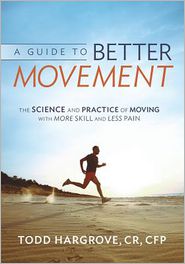I’m currently navigating the deep waters of Strength Training and Coordination: An Integrative Approach by sprint coach Frans Bosch. This is some thick reading. Among many things, he discusses two concepts that have grabbed my attention.
Move with intent
I’ve read and written in the past about the idea of internal vs. external movement cues. Anyone who’s golfed, skied, played tennis or performed almost any sort of sporting movement knows that if we focus on how we execute the movement (internally directed) then we’re screwed. Rather, if our focus on accomplishing the task or directed on our environment (externally directed) then we have a good chance of performing well. The way we direct movement is fairly powerful. Bosh makes several statements that have drawn my attention.
- “If two or more movements share the same intention, then the system marks them as related.”
This goes to sport specificity. It matters in that if we want a particular exercise to transfer to our sport then the strength movement should share the same intent as the sport movement. - “So the body does not think in terms of processes, but in terms of the results of the movement.”
This happens constantly throughout our day. When we step out of the car, put something on a shelf, lift groceries out of the trunk, etc. we don’t think of how the joints, bones and muscles do the job — we just do the job. Why don’t we take the same approach to our gym exercises? - “In coaching, including sport-specific strength coaching, this transfer must be effected as as well as possible. That is why it is a good idea, wherever possible, to add an intention to a strength exercise that has no clear intention of its own.”
This relates to the first bullet point. I must work to choose the right language and analogies in order to get my clients to use an external focus. Choosing the right language is sometimes very challenging! - “If attention is focused outside the body on features related to the movement, then the movement and motor learning processes will be controlled more effectively. Controlling movements effectively is thus a matter of focusing attention externally, and hence using vision effectively (making optimal use of central and peripheral vision).”
The execution of movement skills suffer if the athlete pays too much attention to how the task is performed. Look at targets. Move toward or away from them. - “Directing attention at the result and hence the intention of the movement provides room for the intended organization of the movement…”
Intent-driven movement with an external focus fits with how we learn motor control. In contrast, focusing on contracting muscles, joint position, and posture goes against the way in which we learn to move. (Think of how a baby learns to move. No one gives a baby instructions on how to roll, reach, crawl, or stand up. The baby just figures it out.) - “Besides providing information for learning, KP [knowledge of performance which is externally directed] information also increases motivation, which may well be the most important driving force in learning.”
Motivation is TREMENDOUSLY IMPORTANT!
Movement variability
Movement variability is a big deal. (I’ve discussed it here, here and here.) Bosch talks about movement monotony and variability:
- “However… if the movements during coaching are repeated again and again in an unchanging environment, the learning effect will be less than if the performance and the practice environment keep changing. The link between sensory and motor patterns must be shaken up in order to generate motivation to learn. Sensorimotor chaos is, if you like, the basis for learning. (Schollhorn et al., 2009)”
Doing the same thing the same way in the same environment gets boring. We don’t learn when we’re bored. By varying the training environment we can avoid boredom, maintain motivation and thus keep learning. Thus, I need to continually change things for my clients and myself. - “It [variation] is so important that the reason why periodization models appear to work so well is not the perfect planning of the components in relation to one another, but above all the simple fact that periodization leads to variation in training.”
I’m not sure this is entirely true but it’s an interesting idea. I wish he would provide data to back this up. I hope it’s true but I’d like to see supporting information. - “Variation is therefore the first and most important training principle, along with individualization.”
This makes sense. In the simplest terms, if we never add weight, speed, volume or complexity to an exercise then it is impossible to make progress. - “Of course it is training for endurance sports that is at most risk of monotony… However, if the athletes include strength training in their total programmes, variation increases. That is why strength training for endurance athletes yields not only coordinative and perhaps physiological benefits, but also the important benefit of reducing monotony in coaching.”
I’m glad to hear this. If variation is as vital as Bosch suggests, then gym work is a simple way to provide that variability. I have several questions:- What’s the best way to strength train endurance athletes?
- Endurance sports vary widely from swimming to running to cycling to skiing. Does each discipline require different strategies?
- Should strength work replace some endurance work?
- What’s the best way to fit strength work into the endurance athlete’s training schedule?
There’s more to read and digest…



